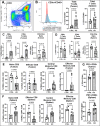Depletion of tumor-derived CXCL5 improves T cell infiltration and anti-PD-1 therapy response in an obese model of pancreatic cancer
- PMID: 40121029
- PMCID: PMC11931939
- DOI: 10.1136/jitc-2024-010057
Depletion of tumor-derived CXCL5 improves T cell infiltration and anti-PD-1 therapy response in an obese model of pancreatic cancer
Abstract
Background: CXCR1/2 inhibitors are being implemented with immunotherapies in PDAC clinical trials. CXC-ligands are a family of cytokines responsible for stimulating these receptors; while typically secreted by activated immune cells, fibroblasts, and even adipocytes, they are also secreted by immune-evasive cancer cells. CXC-ligand release is known to occur in response to inflammatory stimuli. Adipose tissue is an endocrine organ and a source of inflammatory signaling peptides. Importantly, adipose-derived cytokines and chemokines are implicated as potential drivers of tumor cell immune evasion; cumulatively, these findings suggest that targeting CXC-ligands may be beneficial in the context of obesity.
Methods: RNA-sequencing of human PDAC cell lines was used to assess influences of adipose conditioned media on the cancer cell transcriptome. The adipose-induced secretome of PDAC cells was validated with ELISA for induction of CXCL5 secretion. Human tissue data from CPTAC was used to correlate IL-1β and TNF expression with both CXCL5 mRNA and protein levels. CRISPR-Cas9 was used to knockout CXCL5 from a murine PDAC KPC cell line to assess orthotopic tumor studies in syngeneic, diet-induced obese mice. Flow cytometry and immunohistochemistry were used to compare the immune profiles between tumors with or without CXCL5. Mice-bearing CXCL5 competent or deficient tumors were monitored for differential tumor size in response to anti-PD-1 immune checkpoint blockade therapy.
Results: Human adipose tissue conditioned media stimulates CXCL5 secretion from PDAC cells via either IL-1β or TNF; neutralization of both is required to significantly block the release of CXCL5 from tumor cells. Ablation of CXCL5 from tumors promoted an enriched immune phenotype with an unanticipatedly increased number of exhausted CD8 T cells. Application of anti-PD-1 treatment to control tumors failed to alter tumor growth, yet treatment of CXCL5-deficient tumors showed response by significantly diminished tumor mass.
Conclusions: In summary, our findings show that both TNF and IL-1β can stimulate CXCL5 release from PDAC cells in vitro, which correlates with expression in patient data. CXCL5 depletion in vivo alone is sufficient to promote T cell infiltration into tumors, increasing efficacy and requiring checkpoint blockade inhibition to alleviate tumor burden.
Keywords: Adenocarcinoma; Gastrointestinal Cancer; Immune Checkpoint Inhibitor.
© Author(s) (or their employer(s)) 2025. Re-use permitted under CC BY-NC. No commercial re-use. See rights and permissions. Published by BMJ Group.
Conflict of interest statement
Competing interests: None declared.
Figures






References
MeSH terms
Substances
Grants and funding
LinkOut - more resources
Full Text Sources
Medical
Research Materials
Miscellaneous
